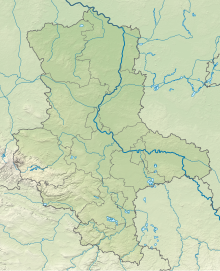Lower Black Magpie
Coordinates: 51 ° 48 ′ 0 ″ N , 12 ° 52 ′ 52 ″ E
The Lower Black Elster is a nature reserve in the towns of Jessen (Elster) and Zahna-Elster in the district of Wittenberg in Saxony-Anhalt .
The nature reserve with the sign NSG 0001 is 442 hectares . For the most part, it is part of the FFH area of the same name and part of the EU bird sanctuary “Black Elster estuary”. In the west it is bordered in parts of the conservation area "Elbe Valley - between Elster and Sachau". The area has been under protection since 1967 (date of regulation: September 11, 1967). The responsible lower nature conservation authority is the Wittenberg district.
The nature reserve is located west of Jessen (Elbe) in the Elbe River Landscape Biosphere Reserve . It places a section of the Black Elster lowlands a little below Jessen (Elbe) under protection until shortly before the river flows into the Elbe . There are numerous oxbow lakes of the Black Elster in the lowlands . The Black Magpie itself has been straightened here . Part of the lowland in the area of the nature reserve is subject to river dynamics. Some of the oxbow lakes are behind flood dikes.
The lowlands are predominantly characterized by moist to wet grassland with fens and swamps . Reed grass , needle-swamp rush , fox sedge and brown sedge settle here . Meadow foxtail settles on cultivated areas . Tall herbaceous corridors are u. a. Formed by Siberian iris , divine mercy , yellow meadow rue and common umbel . Siltation areas of the oxbow lakes are u. a. ingested by marsh hayweed , mud flats , rooting ledges , swaths of water , marsh horsetail and marsh wolf milk . The oxbow lakes are occupied by extensive stocks of pond roses as well as occurrences of pondweed and water hose species , water hazel , frog bite and crab claws. Individual trees and groups of trees can be found in the lowlands. These consist mainly of willows ( basket , broken , gray , purple and almond willows ), partly also from thorn bushes such as the single hawthorn and English oak . Common hedgehog cob and common arrowweed grow in the course of the Black Elster . On the flood protection dykes settle u. a Vinegar rose , field litter , fine-leaved yarrow and heather carnation .
The nature reserve is the habitat of Elbe beavers and otters . The fish asp , hazel , aland , chub , bleak and bitterling live in the Black Elster . Rich pond mussels can be found in the waters in the nature reserve , and the spring gill foot occurs in small bodies of water . Amphibians and reptiles are by Moorfrosch , pond frog , marsh frog , natterjack toad , toad , fire-bellied toad and sand lizard represented, dragonflies example, banded demoiselle and In early reeds hunters . Even birds are represented rich. So breed here u. a. Marsh Harrier , Red Kite , Black Kite , cormorant , teal , shoveler , red-necked grebe , little grebe , Spotted Crake , Water Rail , Lesser Spotted Woodpecker , Gray Shrike , Red-backed Shrike , Wryneck , Kingfisher , Nightingale , Sandpiper , Ringed Plover , Great Reed Warbler , Sedge Warbler , Whitethroat , barred warbler , Beutelmeise and tailed Tit . The nature reserve is a feeding habitat for sea eagles and honey buzzards . It is also a resting and wintering area for numerous water birds .
The nature reserve is often bordered by agricultural areas , and forest areas in the northeast and east. At Gorsdorf - Hemsendorf a district road crosses the valley.
literature
- Guido Warthemann, Birgit Krummhaar: Vegetation and faunistic studies in the NSG “Untere Schwarze Elster” Part I: Vegetation. In: Nature Conservation in the State of Saxony-Anhalt , Volume 34 (1997), Issue 1, pp. 3–14 ( PDF file , 5.7 MB).
- Klaus-Jürgen Seelig, Bernd Simon: Vegetation and faunistic studies in the NSG “Untere Schwarze Elster” Part II: Fauna. In: Nature Conservation in the State of Saxony-Anhalt , Volume 34 (1997), Issue 2, pp. 3–12 ( PDF file , 4.5 MB).


